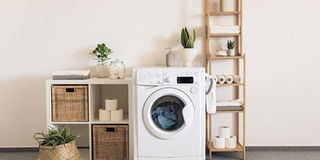Prime
What to consider when building a laundry room

Accessories include hampers, wall hooks, air fresheners, utility trolley, garment steamer and shelving units.PHOTOS/UNSPLASH.COM.
What you need to know:
In order to integrate laundry tasks seamlessly into daily routines, a laundry room can be situated near various house areas such as the kitchen, hallway, or main living spaces.
The laundry room is a functional space dedicated to the tasks associated with cleaning, washing, drying, and maintaining a household’s laundry. Benjamin Gahwera an architect, says laundry rooms are designed to simplify and streamline the laundry process while providing comfort, convenience and efficiency for household members.
“They serve as a central hub for household laundry routines and maximise efficiency,” Gahwera says,
Planning
There are several factors to be considered when planning construction of a laundry room. Gahwera urges homeowners to carefully consider the functionality and layout of space in order to ensure it meets a homeowner’s specific needs and requirements.
“Usually the first step when planning a laundry room is to access the available space, take accurate measurements of the dimensions, and determine the layout that includes the location of plumbing and electrical outlet and configuration of the space to inform design decisions,” says Gahwera.
The next factor is the design elements. These include colour schemes, flooring, lighting and décor to create a visually appealing and cohesive laundry room environment.
Finally, as a homeowner, you need to draw a budget by making estimates for the necessary materials, appliances and any professional services required for installation.
“Based on the provided information, this will help you prioritise certain features or make decisions to stay within the budget constraints depending on your needs and resources,” Gahwera adds.
Location
Positioning is an important aspect in construction. When considering the location of laundry rooms in relation to the direction of the sun for hanging clothes, Charles Bakyayita, a civil engineer, advises homeowners to position the laundry room on the side of the house that receives the most sunlight during the day.
Bakyayita says, “By positioning the laundry room on this side, you can easily access outdoor drying areas such as a backyard or patio where clothes can be hung to dry in the sunlight. This layout takes advantage of natural sunlight to help sanitise and freshen laundry.”
Additionally, you can install windows or doors that open directly to the outdoor drying area, an option that makes it convenient to transfer clothes back and forth between the indoor and outdoor spaces.
In order to integrate laundry tasks seamlessly into daily routines, a laundry room can be situated near various house areas such as the kitchen, hallway, or main living spaces. This allows for convenience and functionality.
Further still, as washers and dryers are known to generate noise during operation, considering locating the laundry room away from sensitive areas of the house, such as bedrooms, home offices, or entertainment spaces minimises disruption of residents.
Finishing
Designing a laundry room requires use of a cohesive colour schemes and design styles that complements the rest of the home’s decor. This can be done by adding decorative elements such as adorning decals, wallpaper patterns, tile backsplashes, and artwork that reflects your personal taste and complements the design theme of the room. Additionally, using light and bright colours helps create a sense of cleanliness and spaciousness.
Include features such as countertops, folding tables, and ironing stations for sorting, folding and ironing clothes. These features not only add to functionality but also make user’s laundry work easier. Other elements include adding indoor plants or potted herbs to bring a touch of nature into the laundry room and improve air quality.
Flooring
Since laundry rooms are high-traffic areas prone to spills and moisture, prioritising durability, water resistance, ease of cleaning and safety, is crucial when selecting flooring materials. Flooring materials need to be waterproof to prevent warping, swelling, and mold growth.
“Although ceramic or porcelain tile is a popular choice for laundry room flooring due to its durability and ease of maintenance add textured or matte finishes to enhance slip resistance,” Gahwera advises.
Storage space
Gahwera suggests several storage solutions one can incorporate into their laundry room including of vertical storage solutions such as wall-mounted cabinets, shelves, and pegboards to maximise storage capacity without taking up valuable floor space.
Other solutions such as incorporating multipurpose furniture pieces such as storage benches, fold-down drying racks to air-dry delicate garments or hang wet clothes, and ironing station with a built-in ironing board that folds down from the wall or slides out from a cabinet.
Drainage
According to Denis Mubiru, a plumber, for efficient water flow and proper disposal of wastewater for a laundry room, it is important to have a floor drain. A floor drain quickly removes any spills, leaks, or overflow water, which in turn prevent water damage to flooring and reduces the risk of mold and mildew growth.
He recommends installing a standpipe or utility sink to provide a dedicated drainage point for the washer, in case there is no floor drainage.
Ventilation
The room is prone to moisture, odours, and airborne pollutants from the laundry activities. Through implementing proper ventilation measures in your laundry room, you can create a healthier and more comfortable indoor environment while promoting the efficient operation of laundry appliances.
This can be done by using a fan with adequate airflow capacity for the size of the room, ensuring that the dryer is properly vented to the outdoors through a vent pipe, installing ventilation louvers on exterior walls or doors to allow fresh air to enter the room while removing stale air. Additionally, cleaning and maintaining ventilation ducts, exhaust fans, and dryer vents regularly to ensure optimal performance and prevent blockages.




